Organic azides photolysis in the crystalline state: the mechanism of polymer formation.
S.V. Zelentsov, A.V.Oleynik
Nizhnii Novgorod University
The Chemical Department, Nizhnii Novgorod University, Gagarin Ave., 23.
Nizhnii Novgorod 603600 Russia
E-mail: zelen@ichem.unn.runnet.ru
Nizhnii Novgorod University
The Chemical Department, Nizhnii Novgorod University, Gagarin Ave., 23.
Nizhnii Novgorod 603600 Russia
E-mail: zelen@ichem.unn.runnet.ru
The organic azides decompose under U.V. exposure to form polymers [1-4] that are new and very promissing materials: Their resistance to oxygen plasma has been estimated to be high enough [5,9], they are able to become electroconductive after doping with inorganic substances [8]. Unfortunately, neither the chemical nature of the polymers, nor the mecanisms of their fomation has been established up to now. This paper systemizes our results in the field.
Reiser and coworkers [3] is seemed to be the first who have described the mechanism of the polymer formation. They have proposed that the polymer molecules have been formed as the result of singlet nitrene, RNS, insertion into C-H bond of phenyl rings.
 (1)
(1)
Almost simultaneously Bö ssler and Schultz [4] have reported that the polymers formed from aromatic azides under u.v. irradi
ation have been azopolymers. Unfortunately, they have no described the reaction mechanism.The formation of plasma resistant azopolymers has been postulated also in [9] and in japanese works [10,11]:
 (2)
(2)
and in [12]
 (3)
(3)
Another japanese research group [13] to interprete photoelectron spectra of polymer being formed under u.v. irradiation of phenylazide freezed onto a gold substrate at 77 K has had to return to the idea proposed by Reiser and Leyshon (reaction 1). These workers have written down the polymerization mechanism as in the following scheme.
 (4)
(4)
The attemp to detalise the mechanism of the azopolymer formation under u.v. irradiation of aromatic azides in the crystalline state has been undertaken in [14-16]. In the first step of the mechanism proposed in [14] there has place an azide decomposition to form a nitrene in the triplet (ground) and the singlet (excited) state.
 (5)
(5)
The nitrenes formed have been able to react with an adjacent azide molecule, the reaction having been carried out without an additional u.v. light absorption.
 (6)
(6)
In the next step the biradical formed could react with another adjacent azide molecule and so on up to the azopolymer formation.
 (7)
(7)
 (8)
(8)
The authors of [15] has shown that the mechanism has had to be implemented with an H atom abstraction reaction in the case of vacuum deposited layers made of 4,4’-diazidediphenyl (that have been considered [15] as being amorphous):
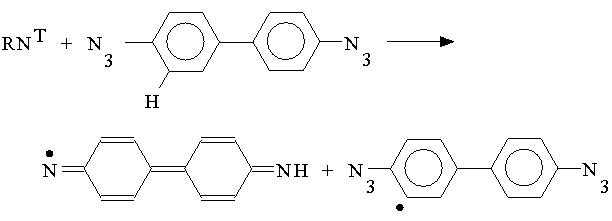 (9)
(9)
the recombination of the nitrene and an hydrocarbon radical having been to take place as following:
 (10)
(10)
Recently the workers [8] from Holland have proposed the polymer formation mechanism consisting of aromatic azide photopolymerization with didehydroazepine derivatives participation as intermediates.
 (11)
(11)
Thus our brief review has shown that either the chemical nature of the polymeric product being formed under an aromatic azide photolysis in the crystalline state or the mechanism of the polymer formation are far away to be established.
To determine the chemical nature of polymer product formed in the aromatic azide photolysis in the crystalline state we have used thin layer chromatography (TLC), IR spectroscopy, and u.v. spectroscopy. In addition we have simulated aromatic azide crystal packings with atom-atom potential procedure and with envelop trajectoty method [5,6] and have produced quantum chemistry calculations of some reaction paths of the mechanism presented by reactions 5-7 [17,18].
IR spectra investigations could give an important information on the structure of the polymers formed. Fig.1-3 have shown changes of the IR spectra under the photolysis of aromatic azides. They have been recorded with SPECORD 75 IR spectrophotometer Mixtures of the irradiated azide powders and KBr have been pressed into tablets, the latter being used for IR spectra recordings.
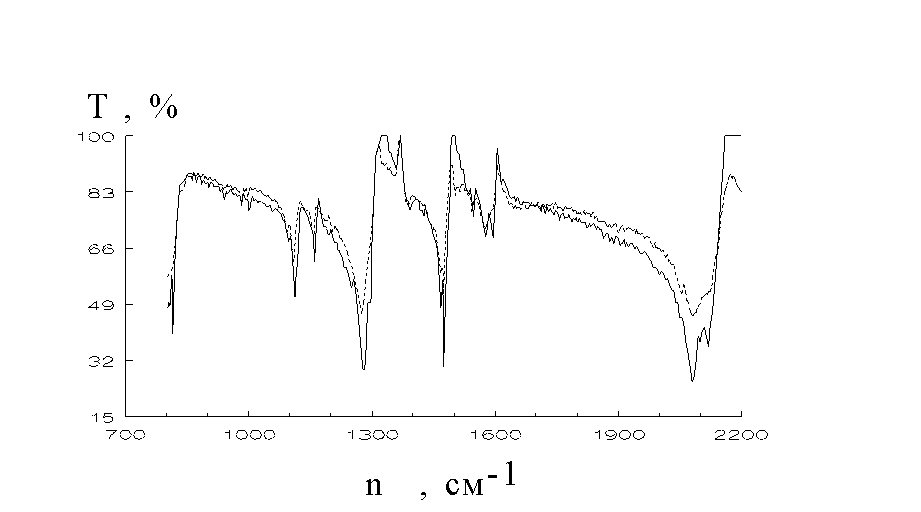
Fig.1 Changes observed in IR spectra of 4,4’-diazidediphenyl in its crystalline state after U.V. irradiation: solide line - no irradiation; dotted line - irradiated sample.

Fig.2 Changes observed in IR spectra of 4,4’-diazidediphenyl ester in its crystalline state after U.V. irradiation: solid line - no irradiation; dotted line - irradiated sample.
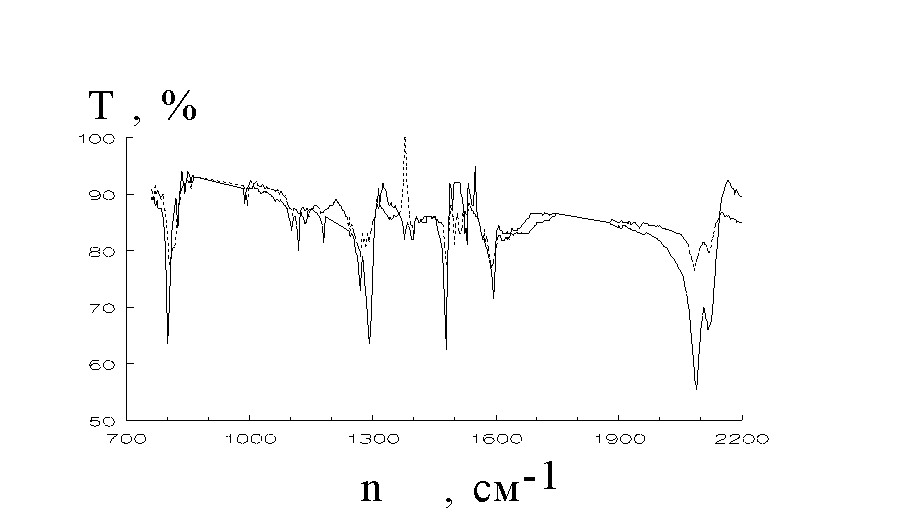
Fig.3 Changes observed in IR spectra of 4,4”-diazide-p-terphenyl in its crystalline state after U.V. irradiation: solide line - no irradiation; dotted line - irradiated sample.
There had place the decreasing of N3 group valence vibrations near 2100 cm-1 and 1300 cm-1 and decreasing of absorptions at 1600-1480 cm-1 and 860-800 cm-1 after u.v. irradiation of aromatic azides. The changes could be consequancies of the lower
p -electron density delocalization in the aromatic rings (for instance, caused by quinonoid structure formation) [22]. In addition we have also observed increased absorptions at 1650-1590 cm-1 and 1340-1250 cm-1. They could be caused by some reasons such as quinonoid structure formation, azocompound involvement (as it has ben shown in [4,23] azocompounds absorbs in the region), C - N and N - H bond participation. To take out between the possibilities we have used chemical analytical methods. Looking through the spectra shown in Fig.1-3 it seems to be necessary to note that there has no place an increase of absorption at 850-690 cm-1 that they have assigned [8] to polymeric 1,2-azepines. There seems to be no reasons to assert that there has place polyazepine formation as a result of the aromatic azide photolysis in the crystalline state.As chemical analyses have shown [14] the amine yield has been low (not more than 0.01% in the case of 4,4’-diazidediphenyl [14]) at crystalline azide photolysis it seems to be unlikely that absorption at 1650-1590 cm-1 could be assigned to NH deformation vibrations. At the other hand reduction of the azopolymer with SnCl2 in concentrated acetic acid has given primary amines. The latter have been identified with the Erlich reaction [19]. The possibility of such identification has been proved by comparison of u.v. spectra recorded in the cases of the reduction product obtained from 4,4’-diazidediphenyl photolysis and 4,4’-diaminediphenyl treatment with Erlich reagent (see Fig.4).
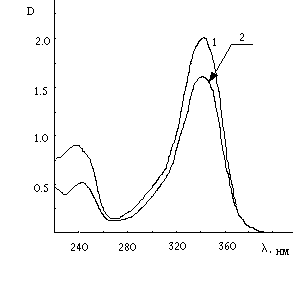
Fig.4 U.V. spectra of diaminediphenyl (1) and the product of reduction of 4,4’-diazidediphenyl (2) photolysis polymeric product by means of SuCl2 in conc. acetyc acid treated by Erlich rearegent.
Thus we have had to conclude that IR spectroscopy together with TLC techniques has given an opportunity to assert that the polymeric products have been azopolymers.
As it was pointed out earlier [5,6] a packing of azide molecules in photoreactive crystals has a great influence upon an azopolymer output. The intermolecular electronic density transfer such as in the reaction 6 is possible only in the case when interatomic distance between “nitreneous” nitrogen atoms of N3 groups of the azide molecules that are to be adjacent in the crystal packing being close to a sum of van-der-Vaalse radii of nitrogen atoms (0.30 nm according to [20]). The packing of 4,4’-diazidediphenyl molecules in crystals seems to be in the closest correspondence to the demands [5,6]. It has stacked layers; the layers being dense packed. It has had the case where we have observed the maximum yield of azopolymer [5,14] and the maximum sensitivity to u.v. irradiation [6]. By-product yield of substances formed with reaction 9 has been observed [5] to be ultimately small and not increasing of 0.01%. The importance of azide packing has been supported with the following. Although types of packing of 4,4’-diazidediphenyl and 4,4”-diazide-p.-terphenyl are similiar but the distance between “nitreneous” nitrogens of azido groups belonging to the adjacent azide molecules being changed from 0.32 to 0.36 nm, the contribution of the reaction 9 in the case of 4,4”-diazide-p.-terphenyl is much greater.
In addition to the distance between the “nitreneous” nitrogen atoms of azido groups of molecules that are adjacent in the crystal packing there has place a great influence of energy that being necessary to form the transitional state structure for the reaction between azide and nitrene molecules.

Fig.5 Reaction mechanism of polymer formation in solid state photolysis of aromatic azide.
A scheme representing the movements of molecules in ultimately dense layer of azide molecules that have been necessary to produce for the said structure has been shown in Fig.5. The results of calculations of energy changes associated with the movements have been shown in fig.6.
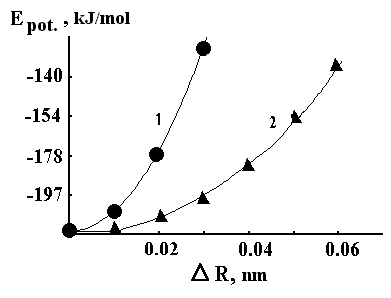
Fig.6 Changes in energy of azide molecule in crystal enviroument during its movement from equilibrium position: 1 - out of plane and along axis Y (that coincides with long axis of the azide molecule); 2 - along axis X that coincides with shoot axis of the azide molecule).
This figure has shown that the movement of azide molecule along its long axis (X direction) is more energy preferable compared to the movement of the molecule along its short axis (Y direction) or the interlayer movement (in the directions being perpendicular to the X-Y plane).
The next argument proving the possibility of azide decomposition as a result of intermolecular electron density transfer between nitrene and azide molecules has been obtained by means of quantum chemistry calculations of reaction HNT + HN3
® HNNHT + N2 ( The MNDO procedure was used).
(a)
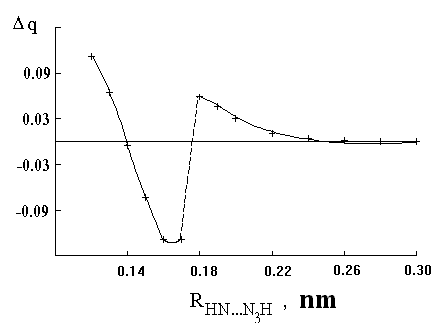
(b)
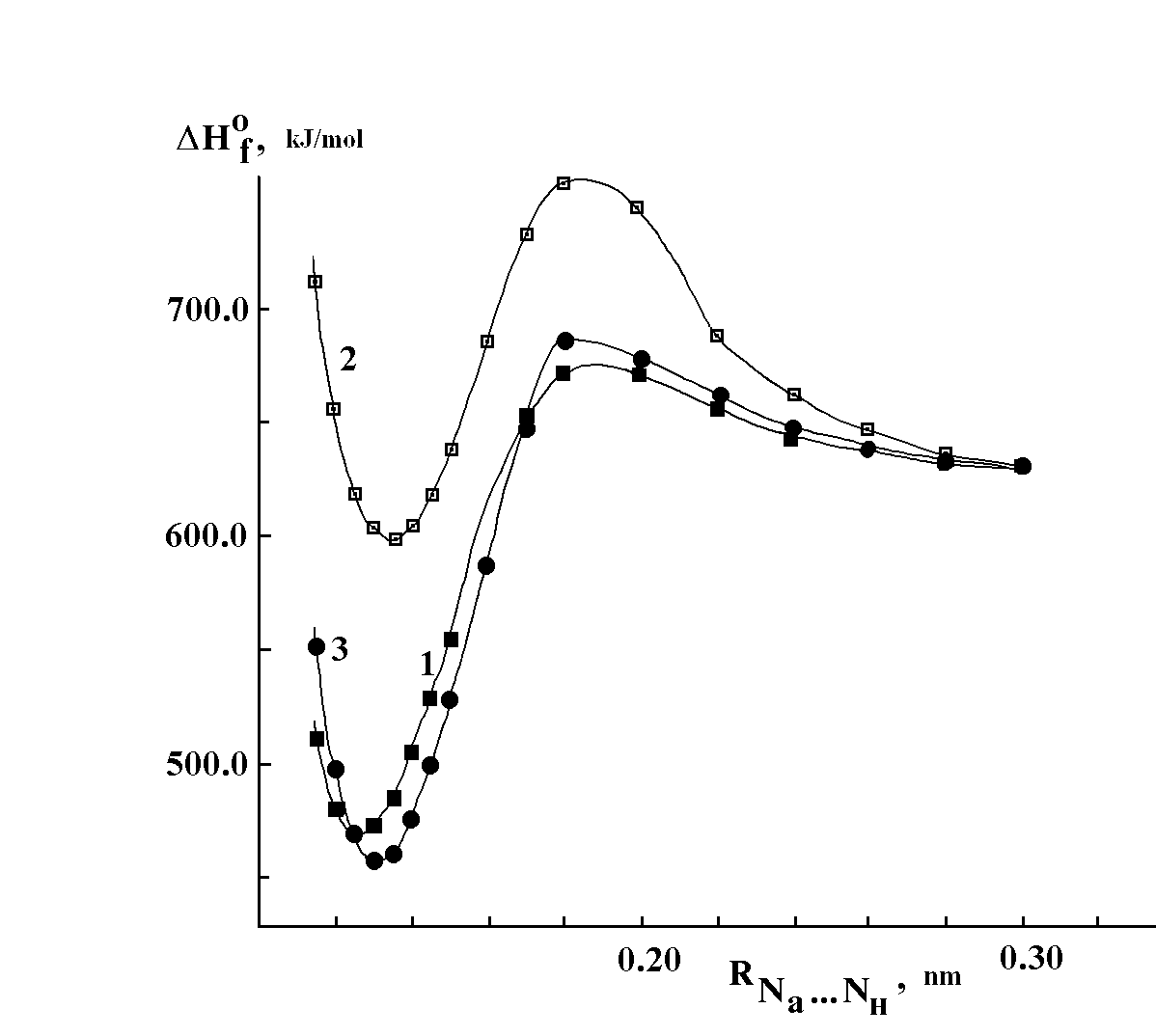
Fig.7 (a) Changes of net charge (compared to the isolated molecule) of N3 group of HN3 molecule during the movement of NH towards “nitreneous” nitrogen of N3 group in HN3 molecule; (b) formation enthalpies of {HN3 +HN}T system as a function of interatomic distance between nitrogen of NH molecule and “nitreneous” nitrogen of HN3 molecule.
Fig.7a has shown the changing of aside group charge during movement of HNT towards “nitreneous” atom of HN3. Fig.7b has shown energy changes as a result of the movement described above. Fig.7a and 7b have shown that there has place “breaking of the monotonous changing” of the charge caused by intermolecular electron density trancfer. The range of intermolecular distances where the said “breaking” having place has corresponded to the range where energy peak separating the starting molecules (HNT and HN3) and products having place. An electron transfer into N3 group has had to cause azide molecule decomposition accompanied with N2 elemination [21].
The results described have given us an opportanity to create scientific basis for development of promissing materials based upon azopolymers by means of photochemical polymerization of the organic diazides.
References.
- Horner L., Christmann A., Gross A. //Chem.Ber.1963.Bd.96.S.388.
- Lwowski W., Scheiffell E. //J.Am.Chem.Soc.1965.V.87.P.4359.
- Reiser A., Leyshon L.J. // J.Am.Chem.Soc.1971.V.93.No.16.P.4051.